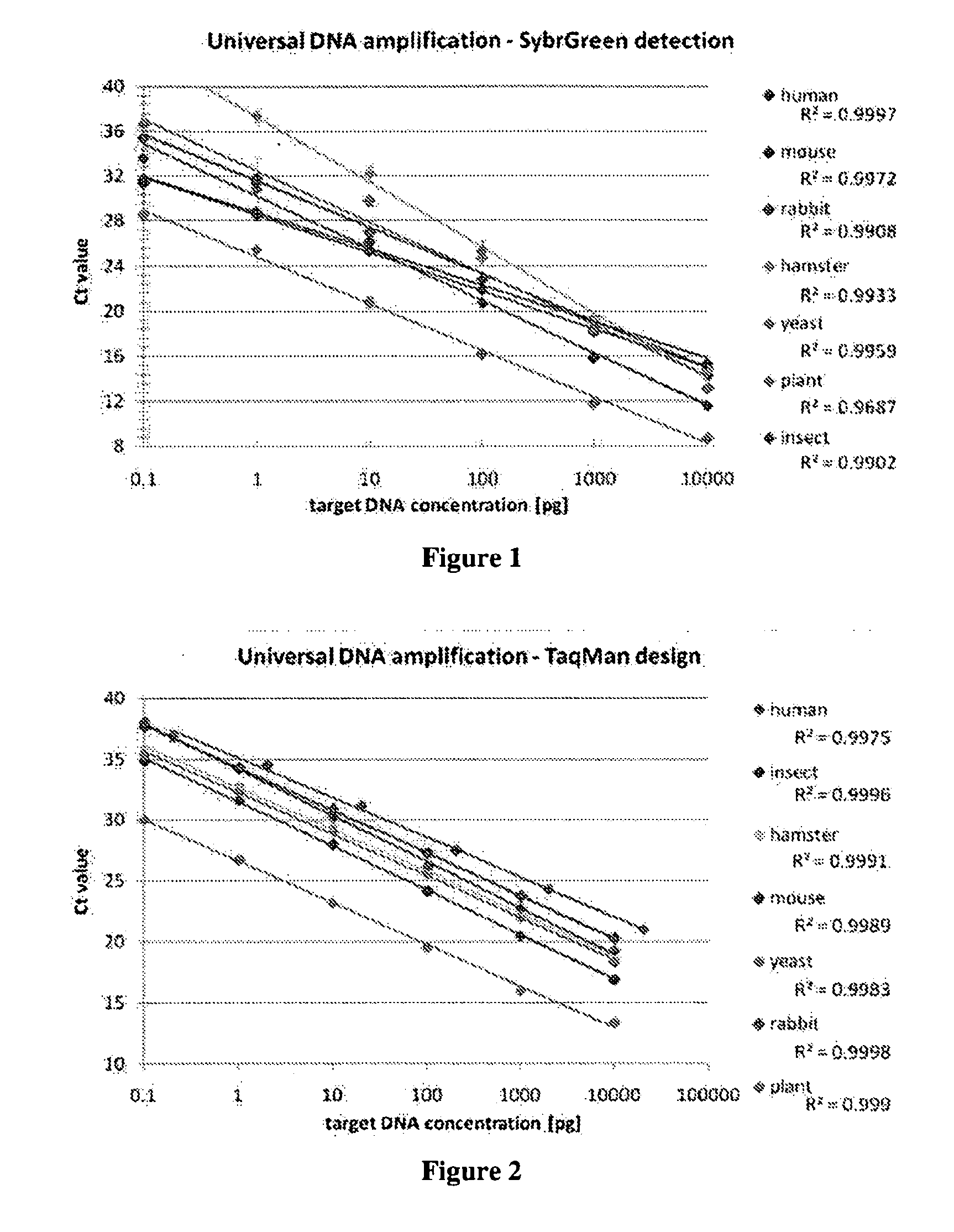Quantification of residual host cell DNA by real-time quantitative PCR
a host cell and real-time quantitative technology, applied in the field of analytic molecular biology, can solve the problems of low pictogram, low reproducibility, and cost, and achieve the effect of low cos
- Summary
- Abstract
- Description
- Claims
- Application Information
AI Technical Summary
Benefits of technology
Problems solved by technology
Method used
Image
Examples
example 1
Residual DNA Assays
[0104]Genomic DNA from various eukaryotic species was quantitated by qPCR using primers targeting the 18S rRNA gene.
[0105]The following primers were used to amplify a 155 bp region of the 18S ribosome gene: forward primer: CGGCTACCACATCCAAGGAA (SEQ ID No.: 1) and reverse primer GCTGGAATTACCGCGGCT (SEQ ID No.: 2).
[0106]The forward and reverse primers were used at a concentration of 100 nM.
[0107]qPCR reactions using SybrGreen readout were performed using SybrGreen Master mix from Applied Biosystems (Foster City, Calif., USA) according to supplier's instructions.
[0108]qPCR reactions were performed in an Applied Biosystems 7500 instrument with 25 μl reaction volumes. The following cycling parameters were used: 50° C. for 2 minutes, 95° C. for 10 minutes, and 40 cycles of denaturing at 95° C. for 15 seconds and annealing at 60° C. for 1 minute.
[0109]Each experiment was done in triplicate.
[0110]Human DNA Quantitation
example 2
Control DNA Spike
[0123]A control DNA is used to spike unpurified samples in order to determine purification yield. The control DNA is a synthetic oligonucleotide whose sequence is not found in any known organism and having the following sequence: AAGCGTGATATTGCTCTTTCGTATAGTTACCATGGCAATGCTAGAACAATAC TAATGTTGTAATCTGTCGCTATGT (SEQ ID No.: 3) (Swango et al, Forensic Science International 158 (2006) 14-26).
[0124]This DNA sequence is quantitated by qPCR using the following primers: forward primer: AAG CGT GAT ATT GCT CTT TCG TAT AG (SEQ ID No.: 5) and reverse primer ACA TAG CGA CAG ATT ACA ACA TTA GTA TTG (SEQ ID No.: 6), and the TaqMan probe having the following sequence: FAM-TAC CAT GGC AAT GCT-MGB-quencher (SEQ ID No.: 7).
[0125]qPCR reactions are done is the same conditions and parameters than in example 1.
[0126]This invention has been described with reference to various specific and exemplary embodiments and techniques. However, it should be understood that many variations and modific...
PUM
| Property | Measurement | Unit |
|---|---|---|
| reaction volumes | aaaaa | aaaaa |
| quantitative real time PCR | aaaaa | aaaaa |
| Threshold Method | aaaaa | aaaaa |
Abstract
Description
Claims
Application Information
 Login to View More
Login to View More - R&D
- Intellectual Property
- Life Sciences
- Materials
- Tech Scout
- Unparalleled Data Quality
- Higher Quality Content
- 60% Fewer Hallucinations
Browse by: Latest US Patents, China's latest patents, Technical Efficacy Thesaurus, Application Domain, Technology Topic, Popular Technical Reports.
© 2025 PatSnap. All rights reserved.Legal|Privacy policy|Modern Slavery Act Transparency Statement|Sitemap|About US| Contact US: help@patsnap.com

